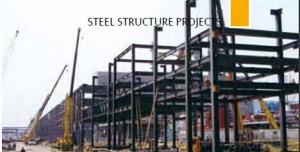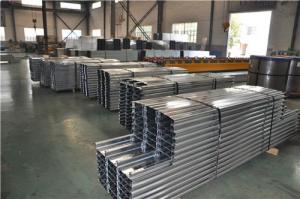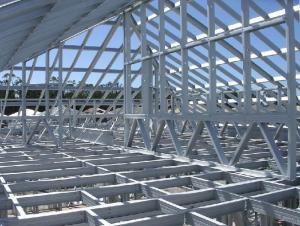High Quality-work made in China
- Loading Port:
- China Main Port
- Payment Terms:
- TT OR LC
- Min Order Qty:
- -
- Supply Capability:
- -
OKorder Service Pledge
Quality Product, Order Online Tracking, Timely Delivery
OKorder Financial Service
Credit Rating, Credit Services, Credit Purchasing
You Might Also Like
Steel Structure
Description:
1.Length of the welding withnot indication, full welding should be applied
2.Seam without indication is fillet weld, height is 0.75t
3.The cutting angle without indication, radius R=30
4.Cutting angle not specified should be
5.The diameter of the hole for the bolt if not specified, D=22

Project Reference:
Area: 17,000m2
Steel Structure Quantity: 2,700ton
Color-Steel Plate Area: 29,670ton
Column Height: 32m
Weight of Per Column: 25ton
Crane Tonnage: 300ton
Total Cost: 25,080,000RMB
Duration: 150days

- Q:What are the fire safety considerations for steel structures?
- Fire safety considerations for steel structures include the use of fire-resistant coatings, adequate spacing and compartmentation, installation of fire detection and suppression systems, and ensuring proper access and egress routes for occupants. Steel structures should be designed to withstand high temperatures, and measures should be taken to prevent the spread of fire and smoke throughout the building. Regular maintenance and inspections are also crucial to ensure the integrity of the steel structure and its fire protection systems.
- Q:How do steel structures provide resistance against vibration-induced human discomfort?
- Steel structures provide resistance against vibration-induced human discomfort through their ability to absorb and dissipate vibrations. The inherent stiffness and strength of steel materials allow them to effectively resist and dampen vibrations caused by external factors such as wind, earthquakes, or heavy machinery. This reduces the transmission of vibrations to the building occupants, minimizing the potential for discomfort or disturbance. Additionally, steel structures can be designed with specialized vibration control techniques, such as using dampers or isolators, to further enhance their ability to mitigate vibrations and ensure a comfortable environment for occupants.
- Q:How are steel structures designed to be resistant to corrosion from saltwater?
- To enhance the resistance of steel structures against saltwater corrosion, various protective measures are implemented. The primary approach involves the utilization of corrosion-resistant materials like stainless steel or galvanized steel. These materials possess a higher tolerance to saltwater corrosion due to their composition and coating. Furthermore, the design of steel structures takes into account the exposure to saltwater and incorporates features that minimize direct contact between the steel and corrosive elements. This can be accomplished by employing coatings or barriers that act as a protective layer, preventing direct interaction with saltwater. These protective coatings encompass paints, epoxy, or specialized coatings specifically formulated for marine environments. Moreover, the prevention of corrosion in steel structures exposed to saltwater heavily relies on proper maintenance and regular inspections. Routine cleaning and elimination of salt deposits, along with the application of anti-corrosion treatments and coatings, aid in maintaining the structural integrity and prolonging its lifespan. Designers also address the potential for galvanic corrosion, which arises when dissimilar metals come into contact in the presence of an electrolyte like saltwater. By employing compatible metals and employing isolation techniques, such as insulating materials or protective coatings, the risk of galvanic corrosion can be significantly minimized. In summary, the design of saltwater-resistant steel structures involves a combination of material selection, protective coatings, regular maintenance, and consideration for potential corrosion mechanisms. Implementing these measures substantially enhances the lifespan and durability of steel structures in saltwater environments.
- Q:How are steel structures designed for different building heights?
- Steel structures for different building heights are typically designed by considering various factors such as the loads the structure will need to support, the building's function, and the local building codes and regulations. The design process involves determining the appropriate steel sections, connections, and bracing systems to ensure structural integrity and stability. Additionally, factors like wind and seismic loads are taken into account to ensure the safety and performance of the steel structure at different heights.
- Q:How are steel structures used in renewable energy projects?
- Due to their strength, durability, and versatility, steel structures find extensive usage in renewable energy projects. A key application of steel structures in such projects is seen in the construction of wind turbines. The turbine-supporting tower is commonly made of steel to withstand strong winds and vibrations, while also enabling the design of tall and slender towers that maximize energy capture. In solar energy projects, steel structures are employed for the construction of solar panel mounting systems. These structures offer a stable and secure platform for solar panels, ensuring optimal exposure to sunlight. Steel's high strength-to-weight ratio makes it an ideal material for these structures, facilitating easy installation and maintenance. Hydropower plants also utilize steel structures, particularly in the construction of penstocks. Penstocks are large pipes responsible for transporting water from the reservoir to the turbines. Steel's corrosion resistance, high pressure and temperature tolerance make it a suitable choice for penstock construction. Moreover, biomass and geothermal power plants rely on steel structures too. In biomass plants, steel is used to construct boilers and storage silos required for biomass combustion. In geothermal power plants, steel well casings are employed to extract hot water or steam from the earth's crust. Overall, steel structures play a critical role in renewable energy projects, providing the necessary support, durability, and efficiency required for successful generation of clean and sustainable energy.
- Q:How are steel structures used in theme parks and amusement rides?
- Steel structures are widely used in theme parks and amusement rides for their durability, strength, and versatility. These structures play a crucial role in ensuring the safety and thrilling experiences of visitors. One of the main applications of steel structures in theme parks is in the construction of roller coasters. The tracks and support systems of roller coasters are typically made of steel, allowing for intricate and gravity-defying designs. Steel's high tensile strength and ability to withstand extreme forces make it the ideal material for creating the loops, twists, and turns that thrill-seeking riders love. Furthermore, steel structures are also used in the construction of other amusement rides such as Ferris wheels, drop towers, and observation towers. These rides often require tall and stable structures, which can be achieved with steel. Steel's excellent load-bearing capabilities allow for the creation of large and complex ride structures that can safely support the weight of multiple passengers and withstand various weather conditions. In addition to their strength, steel structures offer design flexibility, enabling engineers and designers to create unique and visually appealing rides. Steel can be easily fabricated and shaped into different forms, allowing for the creation of intricate and aesthetically pleasing ride elements. This flexibility also enables theme parks to constantly innovate and introduce new rides and attractions to keep visitors entertained and engaged. Moreover, steel structures are durable and require minimal maintenance, making them a cost-effective choice for theme parks. Steel's resistance to corrosion and weathering ensures the longevity of the rides, reducing the need for frequent repairs or replacements. This durability is essential for theme parks, as the rides need to withstand heavy usage and exposure to outdoor elements. Overall, steel structures are essential in theme parks and amusement rides due to their strength, durability, versatility, and design flexibility. They provide the necessary support and safety for thrilling rides and contribute to the overall experience and enjoyment of visitors.
- Q:How are steel structures designed to accommodate natural ventilation?
- Steel structures can be designed to accommodate natural ventilation by incorporating features such as open windows, louvers, or vents that allow the flow of fresh air. These structures can also be designed with strategic placement of openings to take advantage of prevailing winds and create a natural airflow within the building. Additionally, steel structures can be designed with roof overhangs or shading devices to prevent direct sunlight from heating up the interior, thus promoting natural ventilation and reducing the need for mechanical cooling systems.
- Q:How are steel commercial buildings constructed?
- Steel commercial buildings are constructed using a combination of pre-engineered steel components and on-site assembly. The process involves the fabrication and delivery of steel frames, beams, columns, and panels which are then assembled by skilled workers at the construction site. The steel components are bolted or welded together to form the building's structural system, providing strength, durability, and flexibility. This method allows for faster construction times, cost-effectiveness, and the ability to customize the design to meet specific requirements.
- Q:How are steel structures used in theme parks and water parks?
- Steel structures are widely used in theme parks and water parks due to their strength, durability, and versatility. They are utilized for various purposes, including the construction of roller coasters, water slides, observation towers, and other attractions. Steel provides the necessary structural support and stability required to withstand the dynamic forces and loads experienced in these amusement park environments. Additionally, steel's ability to be fabricated into complex shapes allows for creative and visually stunning designs, enhancing the overall experience for park visitors.
- Q:How are steel structures used in the construction of railway bridges?
- Steel structures are commonly used in the construction of railway bridges due to their high strength-to-weight ratio and durability. The use of steel allows for the construction of long-span bridges that can support heavy loads, such as trains. It also provides flexibility in design, allowing for various architectural forms and configurations. Additionally, steel structures are resistant to corrosion, reducing the need for maintenance and ensuring the longevity of the railway bridges.
1. Manufacturer Overview |
|
|---|---|
| Location | |
| Year Established | |
| Annual Output Value | |
| Main Markets | |
| Company Certifications | |
2. Manufacturer Certificates |
|
|---|---|
| a) Certification Name | |
| Range | |
| Reference | |
| Validity Period | |
3. Manufacturer Capability |
|
|---|---|
| a)Trade Capacity | |
| Nearest Port | |
| Export Percentage | |
| No.of Employees in Trade Department | |
| Language Spoken: | |
| b)Factory Information | |
| Factory Size: | |
| No. of Production Lines | |
| Contract Manufacturing | |
| Product Price Range | |
Send your message to us
High Quality-work made in China
- Loading Port:
- China Main Port
- Payment Terms:
- TT OR LC
- Min Order Qty:
- -
- Supply Capability:
- -
OKorder Service Pledge
Quality Product, Order Online Tracking, Timely Delivery
OKorder Financial Service
Credit Rating, Credit Services, Credit Purchasing
Similar products
New products
Hot products
Related keywords

























